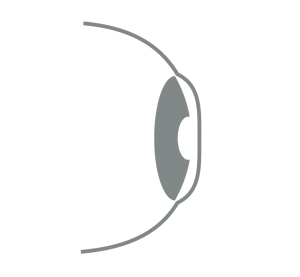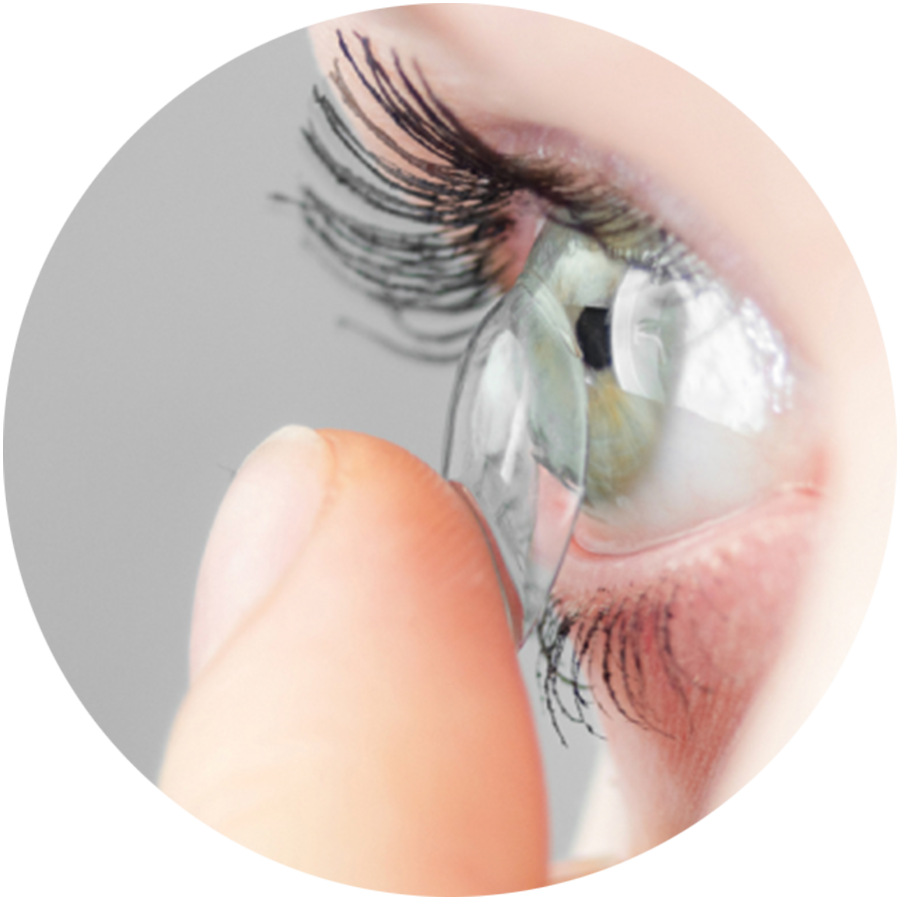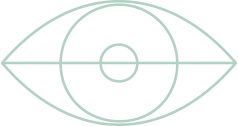A Day in the Life of an Ortho-K Wearer: An Optometrist’s Guide
Table of Contents
For many, waking up with clear vision without needing glasses or contact lenses would be a dream come true. Ortho-K lenses (or orthokeratology) can take you one step closer to this. Ortho-K lenses are a big change from your regular routine of glasses or lenses. Most people are nervous about Ortho-K because the idea of sleeping with lenses in their eyes doesn’t sound comfortable. But in the long run, the benefits can be worth it, especially if you have a higher power or have an active lifestyle.
In this blog, I break down what orthokeratology is and an optometrist-recommended daily routine for Ortho-K — from night-time lens insertion to day-time care — and hygiene tips.
Why Ortho-K for Myopia Management?

FIG 1. NO LENS

FIG 2. LENS FITTED

FIG 3. OVERNIGHT WEAR

FIG 4. LENS REMOVED
Ortho-K lenses offer two powerful benefits: they help slow down the progression of myopia, which is especially important in younger individuals, and they provide clear vision without the need for glasses or daytime contacts, which is beneficial at any age. You wear these lenses overnight, and they temporarily reshape the cornea while you sleep. Reshaping the cornea keeps your vision clear all day without additional correction (in the form of glasses or daytime contact lenses).
The vision correction effect with Ortho-K lenses varies from person to person. If you have a high prescription, you will need a couple of weeks for your power to be fully corrected. People with lower power (less myopia) notice a difference within a few days.
For children, teens, and people in their 20s, orthokeratology plays a crucial role in managing how quickly nearsightedness progresses. This stage of life is when myopia tends to worsen most rapidly, and Ortho-K has been shown to significantly slow that progression. The earlier it’s started, the better the chances of keeping the prescription from climbing and reducing long-term risks to eye health.
Ortho-K is also an excellent option for people who lead active lifestyles. Ortho-K lenses correct your vision while you are sleeping. After you wake up, you don’t need to wear any corrective lenses or glasses during the day. Not having to deal with glasses during sports, or worrying about contacts while swimming or biking, makes Ortho-K a game-changer. It also eliminates everyday hassles like foggy lenses, discomfort from dry eyes, or adjusting your glasses around helmets or hats.
Does Ortho-K cure Myopia?
Myopia causes your eyeball to elongate. There’s no way to cure myopia, but there are ways to slow further deterioration or correct your vision so that in spite of myopia, you can see clearly.
Orthokeratology lenses correct vision by gently reshaping the cornea while you sleep. This effect is temporary and reversible – if you stop wearing the lenses, your eyes will gradually return to their original shape, and your vision will go back to its previous prescription. It’s important to know that discontinuing Ortho-K doesn’t make your myopia worse than it would have been otherwise. However, if you stop using Ortho-K during your teenage years – when myopia often continues to progress – there is a chance your nearsightedness may resume or continue to increase. Whether or not your vision stabilises after stopping depends on several factors, including your age, genetics, and overall eye health.
The Night Before: Night Routine for Ortho-K
Orthokeratology lenses correct your vision at night while you sleep. The night routine for ortho-K lenses simply means putting the lens in before you go to bed.
I recommend putting them on no more than 15 minutes before going to bed. Leaving them in longer will lead to dry and irritated eyes, which can affect the fitting of the lens, and the treatment may not be as effective.
Here’s an Ortho-K night routine:
- Wash your hands: Start by washing your hands and drying them with a lint-free towel.
- Prepare the lens: Take the Ortho-K lenses out of the cleaning solution and rinse them with saline solution.
- Use the lubricating eye drops: Put a few drops of lubricating eye drops directly onto the lenses before placing them in the eyes. This ensures comfort and prevents the formation of air bubbles, which could affect the treatment.
- Ensure a comfortable fit: Once the lenses are in place, close your eyes and relax. A well-fitted Ortho-K lens will rest on the cornea and stay stable throughout the night. Make sure you don’t stay awake for too long after putting the lenses on. When you blink, the lens can move a bit. If you stay awake for too long, you can feel the lens move around, which can be uncomfortable for many people. Once you close your eyes, a well-fitted lens should sit on the cornea and stay stable for the night.
A good night’s sleep — ideally 7-8 hours — is essential for the lenses to work properly. While some people experience initial discomfort, it typically subsides as the patient becomes more accustomed to wearing lenses at night. Children, in particular, tend to adjust quickly to Ortho-K and often prefer it because it allows them to participate in sports and other activities without the hassle of glasses.
In the beginning, some patients need a few days to get used to the lenses while sleeping. That’s because most people are not used to wearing something while they’re sleeping and can be quite aware of it in the beginning. The discomfort wears off quickly, especially if you use it regularly.

Day Routine after Ortho-K Lenses
Upon waking up, the first thing patients should do is remove their Ortho-K lenses. The lenses can be removed using fingers or a suction tool, depending on your preference. A lot of people prefer to put one drop of lubricating eye drops in the eyes before removal.
- You can use your fingers: Wash and dry your hands completely. Use your thumb and middle finger to open your eyelids wide enough to remove the lens with your other hand.
- You can use a suction tool: Wash and dry your hands. Open your eyelids wide and use the suction tool in front of the lens. People prefer to put the suction towards the bottom of the lens, instead of the center. This slowly breaks the seal and suction of the lens from the bottom, instead of a “pop” from the center.
After removal, place the lenses in the cleaning case and soak them with the cleaning solution throughout the day.
After a few nights of consistent Ortho-K use, your vision will be sharp and clear during the day. You won’t need any glasses or daytime contacts. Ortho-K also prevents dry eyes, unlike normal contacts. This is an especially great benefit for people who use a lot of screens or play sports.
Hygiene and Lens Care: Essential Tips
Proper hygiene and maintenance are key to ensuring the long-term success of Ortho-K treatment. Here are some important tips:
- Wash Hands: Before and after handling the lenses, make sure to wash your hands thoroughly to avoid transferring dirt or bacteria.
- Replace Cleaning Solution: Replace the cleaning solution in the case daily — never just top it up. This ensures that the lenses stay clean and safe to wear.
- Case Cleanliness: Keep your lens case clean and change it every 1-2 months.
- Lens Maintenance: Never let the lenses go too long without being replaced. While Ortho-K lenses generally last patients 18-24 months, regular checkups are crucial to ensure that lenses aren’t worn for too long without replacement. Your optometrists can also check that the shape of the lens is correct and that there are no scratches.
Some common mistakes include wearing the lenses too long before sleep, skipping some nights, or not getting regular lens replacements. Consistency is key with Ortho-K treatment; without regular wear, the cornea may return to its original shape, undoing the progress.
Side Effects: What to Expect with Ortho-K
As with any type of contact lens, there are some potential side effects to keep in mind. During the first few days of wearing Ortho-K lenses, some patients may notice halos around lights, particularly at night. This side effect typically fades over a few days as the eyes adjust to the lenses.
High-prescription wearers may not experience perfect vision immediately — full correction can take several days or even weeks. Side effects are no different from those associated with traditional contact lenses, and the infection rate is similar as long as proper hygiene is maintained. Your optometrist can give you more detailed guidance based on your lifestyle and sleep schedule.
The Importance of Regular Check-ups
In the early stages of Ortho-K treatment, regular check-ups are essential to ensure your treatment is progressing as expected. At Vision Camberwell, we recommend a gold standard of a 1-day review, a 1-week review, and a 1-month review after receiving your lenses. These regular reviews in the initial phase ensure that your lens is fitting correctly.
After the initial phase, check-ups should occur every 6-12 months for topography tests, cornea examinations, and slit-lamp tests. During these visits, we conduct the following tests:
- Vision and Refraction Test: To check the patient’s vision and prescription.
- Topography: To assess how well the lens is working to reshape the cornea.
- Cornea Health: To ensure the eye remains healthy and free from infection.
- Slit Lamp Examination: To examine the eye’s health and confirm the lens fits properly.
Most routine Ortho-K reviews do not require retina dilation, though it may be performed every 1-3 years depending on the patient’s eye health.
Conclusion: Patience and Consistency are Key
Ortho-K requires both patience and consistency to achieve the best results. During the first few days, patients may experience some discomfort, but these usually subside as the eyes adjust. While adjusting to the Ortho-K routine may take some time, the benefits — from slowing myopia progression to clear vision throughout the day — make it an excellent option for many people, especially those with active lifestyles or younger patients who are prone to myopic progression.
With regular use, Ortho-K provides an effective and convenient way to manage myopia without the need for glasses or traditional contact lenses during the day. With expert guidance from the team at Vision Camberwell, you can enjoy the long-term benefits of sharper vision and improved quality of life. Get in touch with our team to discuss more about Ortho-K lenses.






